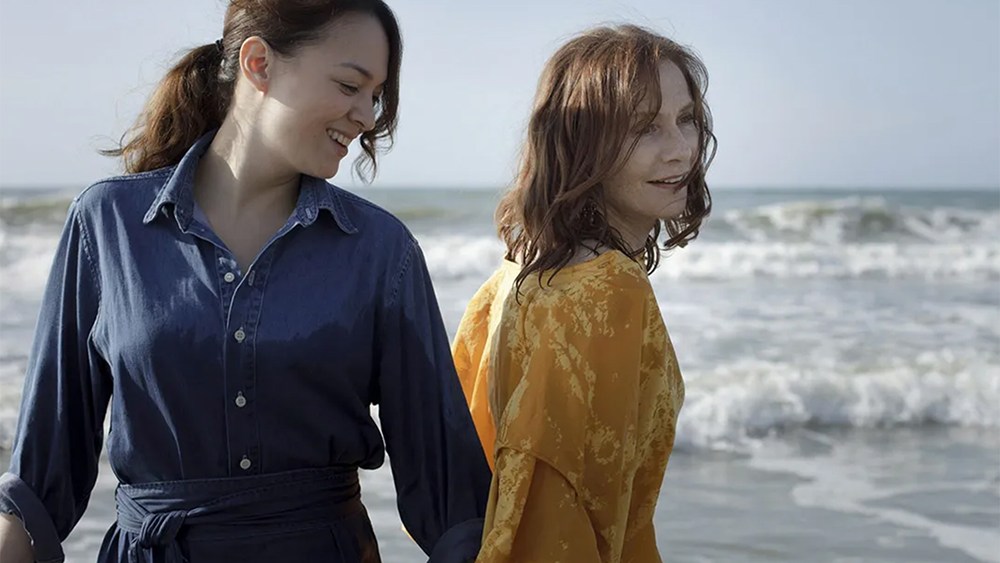Isabelle Huppert Goes Inside a Video Game
Unbothered, Isabelle Huppert vapes while wearing a chic dress after a night out in Paris. The actress’ requisite ferocious grace this time is lent to Sabine, an ailing French artist who refuses to waste her final days bedridden. But she is only one of the four pieces that conform “Luz,” Flora Lau’s alluring narrative diptych on familial disconnection that moves between the French capital, the Chinese city of Chongqing and an interstitial realm of virtual reality, where her characters are meant to find common ground. The geographical divide between the two distinct storylines is bridged via the implementation of this space.
From the opening credits (the names of those involved appear as spinning neon signs floating) propelled by Mimi Xu’s propulsive score, Lau announces the visual originality she’s after, mining Chongqing’s fluorescent architecture to create dazzling, otherworldly frames. And there’s mesmerizing imagery galore in “Luz” (the title means light). A translucid deer roams “virtual streets,” which are presented as footage of the actual places. It’s because of this glistening mammal’s presence that one knows this is not straight reality but an imagined one. If only the drama measured up to the aesthetics, “Luz” would shine.
When not working as a henchman for a crime boss, Wei (Xiaodong Guo) spends hours (and lots of cash) watching his long-estranged daughter Fa (Enxi Deng) on a live stream channel, never showing his face to reveal his relationship to her. The translucid deer from the film’s opening returns in the form of a painting in the karaoke club Wei’s boss owns. The canvas symbolizes a tangible link — a portal one could say — between Wei’s fatherly plight and the inner turmoil carried by Ren (Sandrine Pinna), a young Hong Kong art dealer heading to Paris to visit her stepmother Sabine. Ren’s father is the artist behind the deer piece. To escape their present and meet new people, both Ren and Fan engage in a popular VR game known as Luz. A standard headset with a blue light transports them there.
In “Luz,” users have numerous options for environments to explore; a tongue-in-cheek bar scene shows Wei trying to engage with a holographic bartender only to realize the artificiality of the entire concept. He’s after Fa and knows he may only be able to find her in this intangible landscape. Inside Luz, Lau and cinematographer Benjamín Echazarreta use first-person perspective, where the camera acts like the character’s eyes (this approach recently found a rousing application in RaMell Ross’ “Nickel Boys”). There’s also an intricate thought process behind how the characters enter and exit the digital world, which features a wave of colorful pixels and geometrical portals.
But for all its seductive stylization, the scenes outside of the in-game Twilight Forest or another urban feel mundane and emotionally lackluster. The testy relationship between Sabine and Ren (both have complicated feelings about the man who brought them together) fails to evolve into a profound exploration of who they are and their long-standing conflicts.
With her beguiling presence and ability to convey disdain or understanding in a single look, Huppert invigorates some of these pedestrian moments with Ren (a sequence in the ocean feels uniquely vibrant). But overall, the material can’t keep up with her. The sin of some of the narrative beats in “Luz” is being too conspicuously predictable, such as the fact that the older characters (Sabine and Wei) initially don’t grasp the utility of the immersive technology but ultimately come around to it by the hand of the young women in their lives.
When in Luz, the insecure Ren morphs into a self-assured heroine. Meanwhile, Wei allows himself a modicum of vulnerability while the headset is on, because he wishes to convince Fa of his parental interest in her. Eventually both stories come together in virtual reality, where Ren meets Wei and ponder their respective motivations to use Luz.
There’s an overall sense of alienation imparted by the further fragmentation of the storylines, along with the introduction of subplots, particularly in Wei’s portion (he’s got a male friend in need of a large sum of money and is seeing a woman who has a young daughter). At one point, Wei tries to sell an impressive falsified copy of the deer painting by Ren’s father, implying that the replica can produce a similar feeling as the authentic. For Lau, it seems, that sentiment extends to the entirety of virtual reality.
Can an illusion elicit the same reaction as the real experience? And what makes one more valid than the other, if both have mental consequences? The well-intentioned “Luz” poses these mind-expanding questions, but is devoid of the gumption to pursue them meaningfully. Yet the film is not pensive enough to exist as a strictly meditative art house piece. Although Lau’s intent to evince that technology can bring us closer just as much as it drives our distancing couldn’t be more prescient, the bulk of the attention went to its conceptual aspects and not as much to the heart of its human users.


